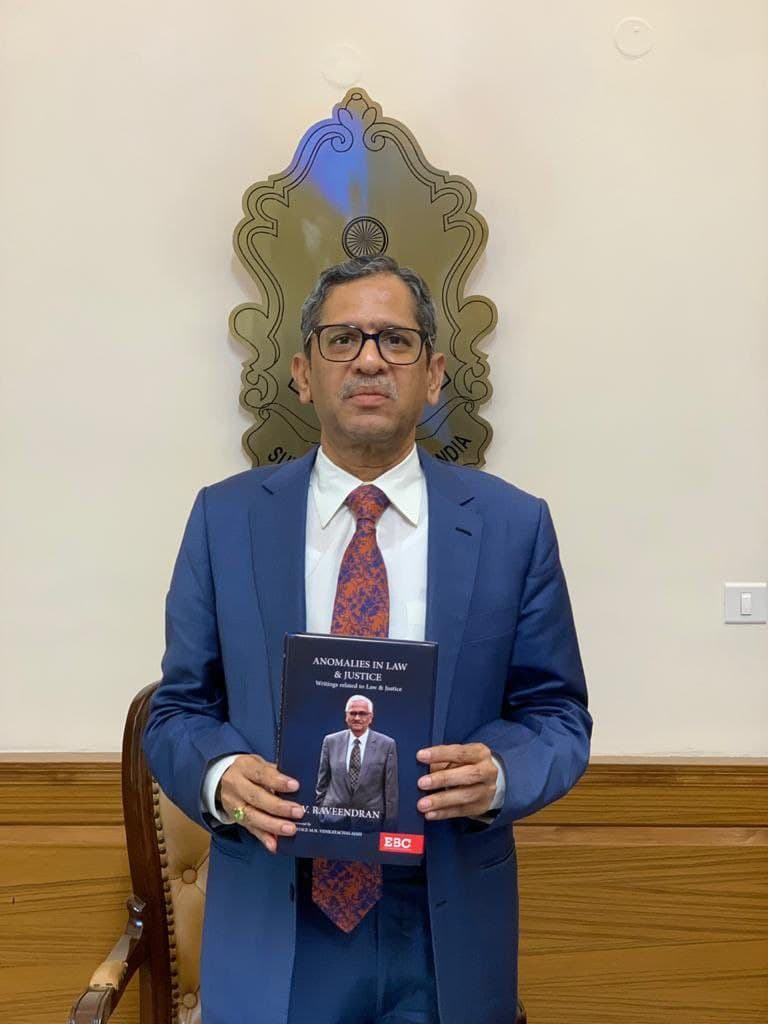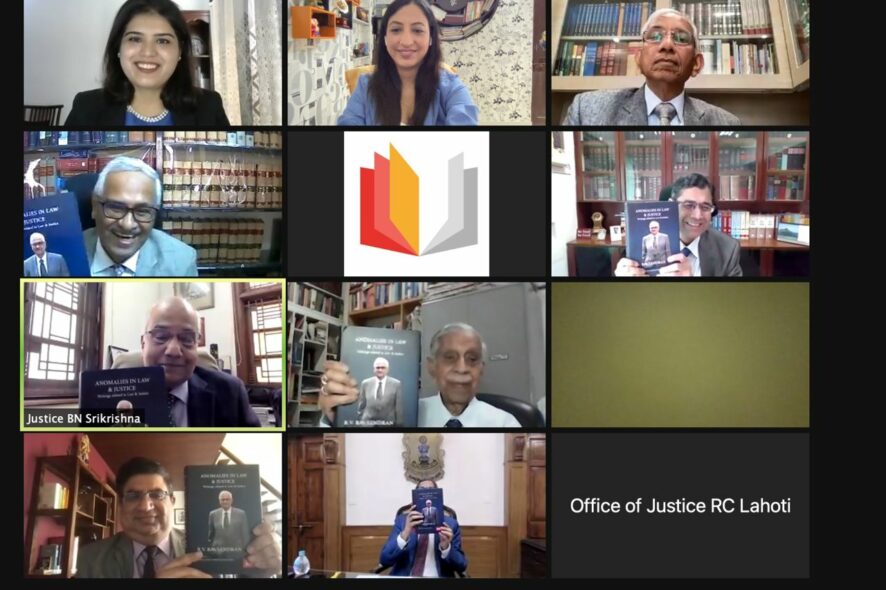The book release of ‘Anomalies in Law & Justice’ authored by Justice Raveendran and published by Eastern Book Company took place today on 26th June, 2021 in an online event. Justice NV Ramana, Chief Justice of India released the book in the presence of an august gathering which included Justice Ventakachaliah, former Chief Justice of India, Justice RC Lahoti, former Chief Justice of India and Justice BN Srikrishna, former judge, Supreme Court.
The program began with Mr Sumeet Malik, Director of EBC Publishing Pvt Ltd., giving a welcome address and introducing all the panelists. He also spoke about EBC and about the evolution of the publishing industry.
Justice Venkatachaliah, former Chief Justice of India, was the next person to give a speech. He congratulated Justice Raveendran on his new book and said that this is the only book whose foreword he has written in the last 30 years. He stated that he had great regard for Justice Raveendran and went on to say that “In his articles Justice Raveendran reveals his personality of being tough & being gentle. Someone asked him once how he was so hard yet so gentle. He said, if I wasn’t hard, I wouldn’t be alive. If I wasn’t gentle I wouldn’t deserve to live”.
The next person to speak was Justice RC Lahoti. He said that this book had something for everyone, even the seniors would find something in the book to further improve themselves. A law professional, whether judge, lawyer, mediator, arbitrator, counsellor would all benefit from this book. Justice Lahoti urged the CJI to prescribe this book like a textbook in judicial academies.
Justice Srikrishna recalled that he fell in love at first sight when he read certain judgments by Justice Raveendran. Whenever he (Justice Raveendran) wrote a judgement as a junior judge, he (Justice Srikrishna) had no need to read it again. All he had to say was “I agree and sign it”, Justice Srikrishna said. Justice Srikrishna concluded his address by stating that may the good Lord give more power to the author’s pen to produce more such books.
The Chief Justice was next to give his address. He said Justice Raveendran was his guide and inspiration. Talking about the book, Justice Ramana said that the book title was an attempt to explain to the layman that the law and legal system is still evolving andl requires critical thinking to evolve. He said that in this book, Justice Raveendran has identified existing anomalies of law that should engage the attention of both the Bench and the Bar. Before he concluded, Justice Ramana shared a heartfelt message that Justice Raveendran had sent at the time of his appointment as the Chief Justice of India.
‘Dear Justice Ramana, Congrats, best wishes and blessings. These are difficult days. Challenging days. Testing days. Being a Chief Justice requires courage to act, commitment to the cause of justice, concern for the common man, tact to deal with and obtain the cooperation of the brother judges in addition to the qualities expected of a judge. You possess all of them in abundance. Let the almighty lead you to a purposeful, meaningful and successful tenure.’
Justice Ramana said that felt that this message was indeed the road map for his journey as the Chief Justice of India.

The Chief Justice’s address was followed by the panel discussion. Mr Arvind Datar laid out the agenda for the panel discussion which was to discuss delays in disposal of cases, technology and law, and issue of PIL. To reduce delay in disposal of cases, Mr Datar asked the panelists their opinion on the suggestion to increase the age of retirement for High Court judges to 65. Justice Lahoti replied that it was a must. The age of retirement of High Court judges must be the same as Supreme Court judges. Justice Srikrishna said that this suggestion will make a High Court Judge feel that he is independent. Justice Venkatachaliah went on to say he had expressed this in the Chief Justice’s conference in 1993, that all Judges must retire at the same age, not at 65 but at 68.
Mr Datar posed a second question to the panelists, that as far as technology and law is concerned would they recommend a continued hybrid system. Justice Venkatachaliah said that loss of man hours and productivity due to adjournments, going to courts, coming back etc is a lot, and digitisation would help in this regard. He added that his suggestions should be implemented only on a pilot basis and should be considered by experts. Justice Lahoti said that we need not be apprehensive. He gave his own example that 17th March, 2020 was the last physical hearing he took part in, and ever since 100% of his hearings for ADR have been virtual, including asking the most complicated questions, have taken place online without any hiccups. Justice Srikrishna made a point that the problem is not all lawyers, judges, etc. are comfortable with computers. Until all are comfortable, hybrid hearings should be continued.
At this point, Justice Ramana interjected that in a recent meeting many issues were raised such as vaccination of lawyers, judges, staff and family, assistance to the lawyers and the issue of difficulties in using technology, especially in rural areas. Justice Ramana said that he initially thought of calling the telecom companies and requesting them to give internet facilities for lawyers in rural areas. But for now he has instead requested the Law Minister, Shri RS Prasad to request the telecom companies, that through Corporate Social Responsibility they can provide internet centres in talukas and districts where lawyers can come and get uninterrupted services. The Chief Justice went on to say that if one doesn’t take care, one generation of lawyers from rural areas will be left out, which is very serious.
Justice Raveendran gave his response at the end of the panel discussion. He said that the Judiciary plays a key role in making rules of law effective. He said the trust and confidence of people will develop only when people can understand the functioning of the judiciary. He said, as against 35 Judges in Supreme Court and 1080 Judges in High Courts, there are more than 22,000 judges in the subordinate judiciary. As far as the common man is concerned they (subordinate judges) are the face of the judiciary and not the Supreme Court and the High Courts. There is an urgent need to debate the problems and stressful working conditions of the lower judiciary, he reiterated. He stated that he firmly believes that the judiciary has a robust future, and that it only requires judges to pull their socks up and show more commitment and concern to the cause of justice. He concluded by saying the object of his book is not to criticise but to make stakeholders think, debate and attempt to find solutions to improve the performance of Judiciary.
Watch the entire discussion on this link:






